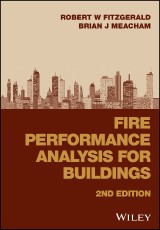Details

Fire Performance Analysis for Buildings
2. Aufl.
|
110,99 € |
|
| Verlag: | Wiley |
| Format: | EPUB |
| Veröffentl.: | 27.03.2017 |
| ISBN/EAN: | 9781118926338 |
| Sprache: | englisch |
| Anzahl Seiten: | 720 |
DRM-geschütztes eBook, Sie benötigen z.B. Adobe Digital Editions und eine Adobe ID zum Lesen.
Beschreibungen
<p>A building fire is dynamic. A continually changing hostile fire environment influences time relationships that affect fire defenses and risks to people and building functions. The fire and fire defenses in each building interact with different sequences and distinct ways. Risks are characterized by the building’s performance.</p> <p><b>Significantly updated and restructured new edition</b></p> <p><i>Fire Performance Analysis for Buildings, 2<sup>nd</sup> Edition</i> organizes the complex interactions into an analytical framework to evaluate any building - at any location - built under any regulatory jurisdiction or era. Systematic, logical procedures evaluate individual component behavior and integrate results to understand holistic performance. The Interactive Performance Information (IPI) chart structures complex time-related interactions among the fire, fire defenses, and associated risks. Quantification uses state-of-the-art deterministic methods of fire safety engineering and fire science. Managing uncertainty is specifically addressed.</p> <p>Key features:</p> <ul> <li>Emphasizes fire performance analysis for new or existing buildings.</li> <li>Augments fire dynamics calculation methods with qualitative methods to form a more complete understanding of the effects of hostile fire characteristics on building performance.</li> <li>Describes fire ground operations for engineers with no fire service experience. An analysis evaluates ways the site and building design help or hinder manual fire suppression.</li> <li>Establishes a transition from traditional structural requirements to modern calculation based structural analysis and design for fire conditions. Structural concepts are described for non-structural engineers to enable the roles of each profession to be integrated into comprehensive performance evaluations. </li> <li>Addresses techniques of managing uncertainty to improve understanding and communication with professionals of other disciplines.</li> <li>Describes methods of risk management using information from the building’s performance analysis.</li> </ul> <p><i>Fire Performance Analysis for Buildings, 2<sup>nd</sup> Edition</i> has been completely restructured around a performance based framework. Applications integrate traditional fire defenses with fire science and engineering to combine component performance with holistic performance.</p>
<p>Preface xxiii</p> <p>Acknowledgements xxv</p> <p>1 Fire Performance and Buildings 1</p> <p>2 Preliminary Organization 9</p> <p>3 Tools of Analysis 31</p> <p>4 An Introduction to the Interactive Performance Information Chart 59</p> <p>5 Quantification 73</p> <p><b>Part II The Parts </b><b>79</b></p> <p>6 The Room Fire 81</p> <p>7 The Room Fire: Qualitative Analysis 119</p> <p>8 Beyond the Room of Origin 147</p> <p>9 Smoke Analysis 175</p> <p>10 The Diagnostic Fire 191</p> <p>11 Fire Detection 193</p> <p>12 Alarm: Actions After Detection 203</p> <p>13 Fire Department Extinguishment: Arrival 219</p> <p>14 Fire Department Extinguishment: First Water (MA) 237</p> <p>15 Fire Department Extinguishment: Control and Extinguishment 295</p> <p>16 Automatic Sprinkler Suppression 305</p> <p>17 The Composite Fire 325</p> <p>18 Materials, Codes, Standards, Practices, and Performance 331</p> <p>19 Concepts in Structural Analysis for Fire Conditions 365</p> <p>20 Target Spaces and Smoke 401</p> <p>21 Life Safety 411</p> <p>22 Risk Characterizations 417</p> <p>23 Fire Prevention 435</p> <p><b>Part III The Analysis </b><b>449</b></p> <p>24 Fire Performance: Framework for Analysis 451</p> <p>25 The Diagnostic Fire 455</p> <p>26 Fire Detection 463</p> <p>27 Fire Department Notification 475</p> <p>28 Fire Department Extinguishment 483</p> <p>29 Automatic Sprinkler Suppression 501</p> <p>30 The Composite Fire 517</p> <p>31 Structural Performance 521</p> <p>32 Target Space Smoke Analysis 525</p> <p>33 Life Safety Analysis 531</p> <p>34 Prevent Established Burning 541</p> <p><b>Part IV Managing Uncertainty </b><b>555</b></p> <p>35 Understanding Uncertainty 557</p> <p>36 Visual Thinking 581</p> <p>37 Introduction to Risk Management 597</p> <p>38 Analytical Foundations 615</p> <p>Appendix A Organizational Structure 637</p> <p>A.1 The Organizational Framework 637</p> <p>A.2 Basic Organization 637</p> <p>A.3 The Composite Fire 637</p> <p>A.4 The Diagnostic Fire (Î) 639</p> <p>A.5 Fire Department Manual Extinguishment 640</p> <p>A.6 Detection 640</p> <p>A.7 Notification 642</p> <p>A.8 Notification to Arrival 643</p> <p>A.9 Arrival to Extinguishment 645</p> <p>A.10 Automatic Sprinkler System 646</p> <p>A.11 Building Response: Structural Behavior 647</p> <p>A.12 Building Response: Space Tenability 648</p> <p>A.13 Risk Characterizations 648</p> <p>A.14 Occupant Movement 650</p> <p>A.15 Other Risks 651</p> <p>A.16 Prevent Established Burning (EB): Occupant Extinguishment 651</p> <p>A.17 Prevent EB: Special Hazards Protection 653</p> <p>A.18 Closure 653</p> <p>Appendix B Model Building 655</p> <p>Description 655</p> <p>Plans 655</p> <p>Index 661</p> <p> </p>
<p> Robert W. Fitzgerald, Worcester Polytechnic Institute, USA<BR> Brian J. Meacham, Worcester Polytechnic Institute, USA
<p>A building fire is dynamic. A continually changing hostile fire environment influences time relationships that affect fire defenses and risks to people and building functions. The fire and fire defenses in each building interact with different sequences and in distinct ways. Risks are characterized by the building's performance. <p>Significantly updated and restructured new edition <p>Fire Performance Analysis for Buildings, 2nd Edition organizes the complex interactions into an analytical framework to evaluate any building – at any location – built under any regulatory jurisdiction or era. Systematic, logical procedures evaluate individual component behavior and integrate results to understand holistic performance. The Interactive Performance Information (IPI) chart structures complex time-related interactions among the fire, fire defenses, and associated risks. Quantification uses state-of-the-art deterministic methods of fire safety engineering and fire science. Managing uncertainty is specifically addressed. <p>Key features: <ul> <li>Emphasizes fire performance analysis for new or existing buildings.</li> <li>Augments fire dynamics calculation methods with qualitative methods to form a more complete understanding of the effects of hostile fire characteristics on building performance.</li> <li>Describes fire ground operations for engineers with no fire service experience. An analysis evaluates ways in which the site and building design help or hinder manual fire suppression.</li> <li>Establishes a transition from traditional structural requirements to modern calculation-based structural analysis and design for fire conditions. Structural concepts are described for non-structural engineers to enable the roles of each profession to be integrated into comprehensive performance evaluations.</li> <li>Addresses techniques of managing uncertainty to improve understanding and communication with professionals of other disciplines.</li> <li>Describes methods of risk management using information from the building's performance analysis.</li> </ul> <p>Fire Performance Analysis for Buildings, 2nd Edition has been completely restructured around a performance-based framework. Applications integrate traditional fire defenses with fire science and engineering to combine component performance with holistic performance.

















